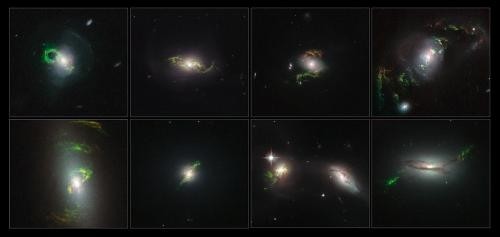NASA's Hubble Snaps the Enigmatic 'Quasar Ghosts'
| Marco Foronda | | Apr 03, 2015 01:58 AM EDT |
(Photo : NASA/ESA/Galaxy Zoo Team/W. Keel (University of Alabama, USA)) Winding green filaments observed by the NASA/ESA Hubble Space Telescope within eight different galaxies. The ethereal wisps in these images were illuminated, perhaps briefly, by a blast of radiation from a quasar -- a very luminous and compact region that surrounds a supermassive black hole at the center of a galaxy.
NASA's Hubble Space Telescope has captured dramatic images of a set of wispy, goblin-green objects, the ephemeral "ghosts" of quasars that once flickered into life and then faded.
The glowing structures have looping, helical and braided shapes. Scientists said they don't fit a single pattern.
Like Us on Facebook
The ethereal wisps outside the host galaxy are believed to have been illuminated by powerful ultraviolet radiation from a supermassive black hole at the core of the host galaxy. The most active of these galaxy cores are called quasars, where infalling material is heated to a point where a brilliant searchlight shines into deep space. The beam is produced by a disk of glowing, superheated gas encircling the black hole.
"However, the quasars are not bright enough now to account for what we're seeing; this is a record of something that happened in the past," sid Bill Keel of the University of Alabama at Tuscaloosa, who initiated the Hubble investigation of the distant objects.
Keel believes the features offer insights into the puzzling behavior of galaxies with energetic cores.
He added the glowing filaments indicate those quasars were once emitting more energy, which they shouldn't do.
He suggests one possible explanation is the quasars may be co-orbiting black holes, which could change the quasar's brightness as they circle each other, acting something like a cosmic dimmer switch.
The first "green goblin" type of object was found in 2007 by Dutch schoolteacher Hanny van Arkel. She discovered the ghostly structure in the online Galaxy Zoo project.
The project enlisted the public to help classify more than a million galaxies catalogued in the Sloan Digital Sky Survey (SDSS), and moved on to add galaxies seen in Hubble images probing the distant universe. The bizarre feature was dubbed Hanny's Voorwerp, Dutch for Hanny's Object.
Keel's team took the galaxies that looked the most promising and further studied them by dividing their light into its component colors through a process called spectroscopy.
In follow-up observations from Kitt Peak National Observatory and the Lick Observatory, his team found 20 galaxies had gas that was ionized by radiation from a quasar rather than from the energy of star formation. And the clouds extended more than 30,000 light years outside the host galaxies.
TagsNASA's Hubble Snaps the Enigmatic 'Quasar Ghosts', NASA, hubble telescope, quasar, Quasar Ghosts, ghosts of quasar, green goblin, space exploration
©2015 Chinatopix All rights reserved. Do not reproduce without permission
EDITOR'S PICKS
-

Did the Trump administration just announce plans for a trade war with ‘hostile’ China and Russia?
-

US Senate passes Taiwan travel bill slammed by China
-

As Yan Sihong’s family grieves, here are other Chinese students who went missing abroad. Some have never been found
-

Beijing blasts Western critics who ‘smear China’ with the term sharp power
-

China Envoy Seeks to Defuse Tensions With U.S. as a Trade War Brews
-

Singapore's Deputy PM Provides Bitcoin Vote of Confidence Amid China's Blanket Bans
-

China warns investors over risks in overseas virtual currency trading
-

Chinese government most trustworthy: survey
-

Kashima Antlers On Course For Back-To-Back Titles
MOST POPULAR
LATEST NEWS
Zhou Yongkang: China's Former Security Chief Sentenced to Life in Prison

China's former Chief of the Ministry of Public Security, Zhou Yongkang, has been given a life sentence after he was found guilty of abusing his office, bribery and deliberately ... Full Article
TRENDING STORY

China Pork Prices Expected to Stabilize As The Supplies Recover

Elephone P9000 Smartphone is now on Sale on Amazon India

There's a Big Chance Cliffhangers Won't Still Be Resolved When Grey's Anatomy Season 13 Returns

Supreme Court Ruled on Samsung vs Apple Dispute for Patent Infringement

Microsoft Surface Pro 5 Rumors and Release Date: What is the Latest?










